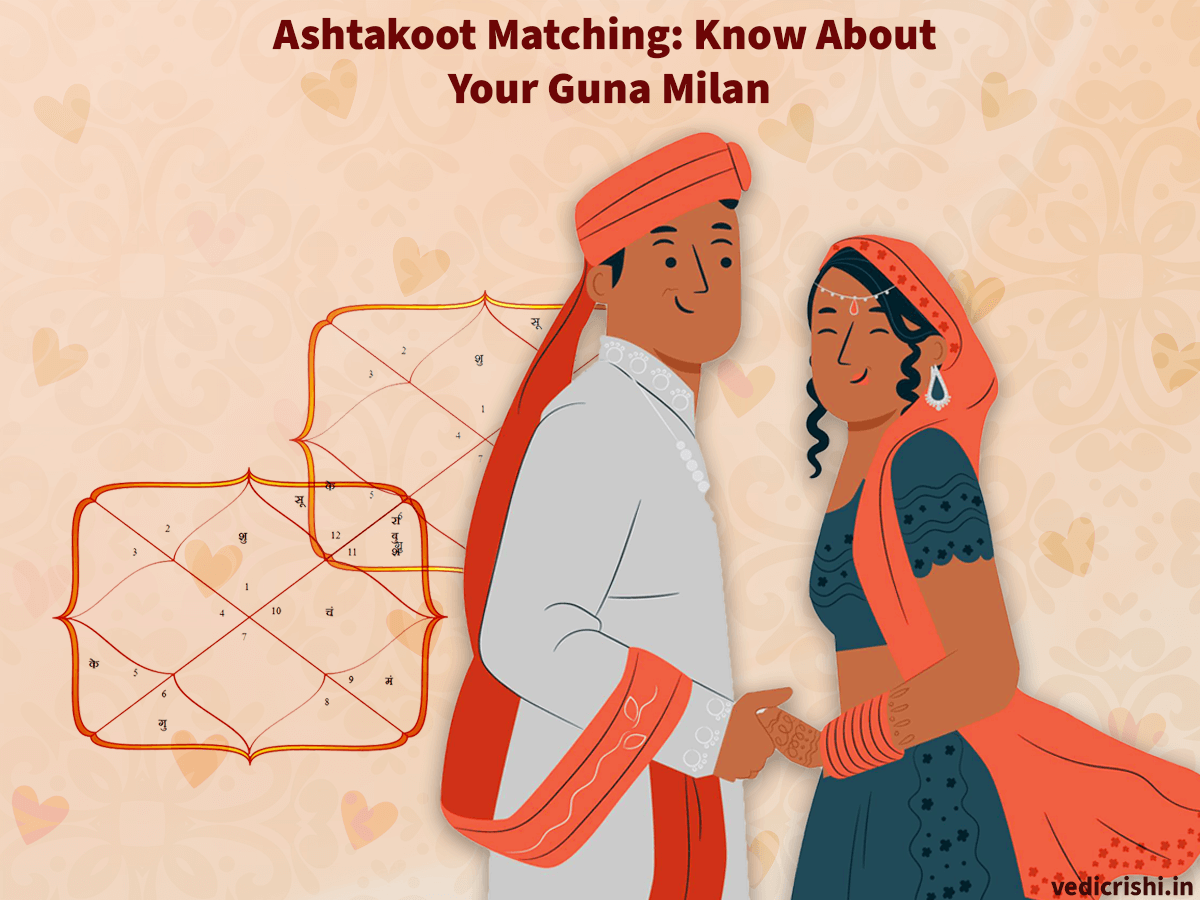ASHTAKOOTA: The Method of Matching the Eight Aspects

Significance of Matchmaking:
Even today, marriage is more or less universal in India. ‘Vivaha’ or Marriage is one of the 16 Samskaras or religious conducts/rites. Samskaras are the different crucial turning points in a person’s life; hence they are respected and celebrated.
Hindu scriptures consider marriage as a very holy union determined even before birth. Hence match-making assumes a great significance to understand the physical, mental, intellectual, and behavioral compatibility of the potential couple. Marriage Matchmaking has now assumed a greater significance with the changing socio-economic conditions and radical modifications in the status and role of women in family life. Besides comparing the educational, cultural, and professional backgrounds, the prospective bride/groom and their parents are also interested in assuring whether their married life will be happy, harmonious, and fruitful too.
What is Match Making?
Marriage Matchmaking is known by different names such as Kundli Milan, Guna Milan, and Lagna Melapak. The main factors to be considered while matching horoscopes are the promise of a long and healthy marital relationship, Guna Milan, Manglik consideration, and the strength of the Navamansha chart.
Guna Milan and Types:
Guna Milan is not to be mixed up with Match Making; it is actually a part of the Kundli Milan. In North India, a very traditional, yet simple method of Guna matching is followed which is called the ‘Ashtakoota Milan’. It literally means the ‘Matching of Eight Qualities or Aspects’. ‘Ashta’ means Eight and ‘Koota’ means ‘aspect’. These eight aspects or kootas are allotted a certain numeric value depending upon their significance or role in deciding different aspects of a couple’s compatibility. The eight Gunas are Varna, Vashya, Tara, Yoni, Graha Maitri, Gana, Bhakoota, and Nadi.
On the other hand, a more comprehensive and complicated method of matchmaking is followed in South India which is known as the ‘DashaKoota (Ten Aspects) Milan’. In this method, Mahendra Koota, Deergha Koota, Vedha Koota, and Rajju Koota too are considered besides the above eight kootas.
The ‘Ashtakoota’ Method of Matching:
Ashtakoota matching means the matching of 8 criteria – each of which is based on the Moon signs and the Natal Moon Nakshatras. The Navmansha Chart is generally not taken into account. Some astrologers consider Manglik dosha too.
The eight Kootas or Aspects of Ashtakoota are as follows:
1. VARNA – This represents the spiritual compatibility of the boy and the girl. It exhibits the ego level and personalities of both. The matching of Varna Koota ensures the existence of mutual love and comfort in marriage life.
2. VASHYA – This measures mutual attraction and the degree to which the partners shall be able to influence each other. In other words, it calculates the power equation between the two.
3. TARA – Tara or Dina Koota indicates the wellbeing and longevity of the prospective couple. Its compatibility ensures that the couple shall remain disease-free and have a long life thereby will be able to enjoy the comforts of a happy conjugal life.
4. YONI – Yoni Koota measures the intimacy levels, sexual compatibility, and mutual love of the prospective couple. It matches the sensuous nature and characteristics of both.
5. GRAHA MAITRI – This reflects the mental compatibility, affection, and natural friendship between the partners. It denotes how inimical the boy and the girl are to each other.
6. GANA – Gana indicates the mutual behaviors, mental compatibility, and temperaments of the prospective bride and groom. This is a vital factor that impacts the compatibility levels of the Partners.
7. BHAKOOTA – This represents the emotional compatibility of the couple. It shows the relative influence of one partner on the other and their capability of realizing mutual understanding and mental acceptance.
8. NADI – Nadi measures the comparative levels of Vata, Pitta, and Kapha between the couple. This shows the impact upon progeny and child-birth issues; it also addresses the health matters and metabolism of the partners. Same Nadi is not recommended for marriage.
The maximum points allotted to each of the above Kootas are as follows:
The scores obtained by the Ashtakoota Milan are to be analyzed as follows:
POINTS OBTAINED RESULTS
33 to 36: EXCELLENT MATCH
25 to 32: VERY GOOD MATCH
18 to 24: ACCEPTABLE; BUT NEED TO CONSIDER OTHER FACTORS MINUTELY
18 Points: NOT COMPATIBLE MATCH
Compatibility between partners is the crux of a successful marital life. Hence accurate calculations and in-depth analysis of the Ashtakoota matching are of utmost importance.
Conclusion #
The traditional Ashtakoota Melapak did not take into consideration the cancellation of three Mahadoshas viz Nadi Dosha, Bhakoota Dosha, and Gana Dosha. However, the contemporary Ashtakoota Milan principles do consider that if the Rashi Lords of the prospective bride and groom are mutual friends or are same planets, then all the Ashtakoota Doshas get nullified or canceled; including the above mentioned three Mahadoshas.
One also needs to keep in mind that the Guna Milan score is just one of the many factors to be considered while deciding the compatibility level between the potential bride and groom. One needs to consider other factors too such as Manglik deliberations, the longevity of the partners, reparative tendencies, financial standing, etc.
Share article:
Explore More
Festival
Are You Ready For Mahashivratri 2023 Celebrations?
Vedic Astrology
Guru Chandal Yoga 2023: Effects on All Zodiac Signs & Remedies
vedic astrology
The Truth About Sun Transiting to Taurus 2022
Festival
Ramnavami Is Coming Up. Are You Ready for the Grand Celebrations?
Remedies
Know the Turmeric Remedies and Benefits in Vedic Astrology
Get your free personalised Vedic Kundli report now
Join over 5 lakh + Vedic Rishi members
Know How Your Year is Going to be with Our Personalized Varshphal Report
Join over 5 lakh + Vedic Rishi members
Get Your Queries Answered by Our Principal Astrologer
Ask your question now
Featured Blogs
Festival
vedic astrology
Vedic Astrology

